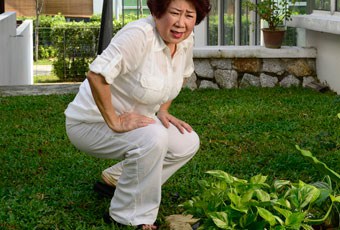NATURAL ALTERNATIVES TO HELP YOU COPE WITH KNEE PAIN.

DOES your knee hurt when you bend, flex or walk, or when you climb the stairs or kneel whilst gardening? If not you personally, maybe your mum, dad or even someone you know is suffering from the excruciating claws of osteoarthritis (OA). You’ve probably read countless articles focusing on the disease itself and the drugs used to treat it.
There are more than 100 types of known arthritis. Osteoarthritis is the most common form of arthritis afflicting ageing adults worldwide. Hence, we will be focusing specifically on osteoarthritis. It affects the hands, feet, spine, and large weight-bearing joints, such as the hips and knees.
This article will centre on what NOT to do when you have osteoarthritis of the knee; many sufferers are unaware that they are aggravating their knee joints by doing the opposite. What will also be covered will be the safer, milder alternative medication options to consider, compared to conventional pain killers.
What not to do when suffering from osteoarthritis of the knee:
- Wearing wrong footwear
- Avoid heels that are too high or too hard.
- Don’t wear sandals. Choose shoes that lace up and provide your feet with firm support.
- Walking uphill or downhill
- Avoid walking up or down steep inclines or hills. Both put considerable strain on the knee.
- Walking on uneven or soft terrain
- Avoid uneven or very soft terrain.
- Carrying heavy objects
- Try not to carry heavy objects as much as possible. Every extra pound you carry increases the stress on your joints because your knees are your biggest weight-bearing joints.
- Standing for long periods at a time
- Do not be on your feet for many hours at a time without a break. This puts your knees under considerable strain, even if you do not feel it directly at that moment.
- Avoid low seats
- Avoid sitting on low chairs.
- Kneeling
- Kneeling, whether at home, at work, or in places of worship, concentrates pressure directly on your knees and should be avoided whenever possible.
In summary, one basic rule for osteoarthritis is: “Movement yes, strain no”.
Now let’s talk about safer, milder yet as effective alternatives to conventional pain killers.
Most people with osteoarthritis do not nourish their cartilage. Supplying essential nutrients for the body helps to build strong, flexible cartilage. Having a strong flexible cartilage is the first step for healthy joints. Hence, with the right nutritional support, osteoarthritis sufferers can rebuilt and regrow their worn out cartilage.
Glucosamine and chondroitin are two clinically proven nutritional compounds used for relief of osteoarthritis and knee pain.
Thousands of osteoarthritic sufferers worldwide are taking this combination daily to support their knee health.
Glucosamine exists naturally in our cartilage and functions to repair and stimulate new cartilage regrowth. However, as our body ages, less amounts of glucosamine is produced. Chondroitin is another natural compound that is found in joint cartilage which gives rigidity to the cartilage and also acts as a “shock absorber”.
The synergistic effects of these two ingredients can help relieve joint pains and improve flexibility. Supplementation with glucosamine and chondroitin helps:
Relieve joint painRebuilds joint cartilageImproves joint flexibility
Remember to avoid doing the things that would put a strain on your knee joint. Regular exercise, coupled with a healthy diet, in addition to taking an effective formula of glucosamine plus chondroitin is a sure way to keep osteoarthritis at bay.
